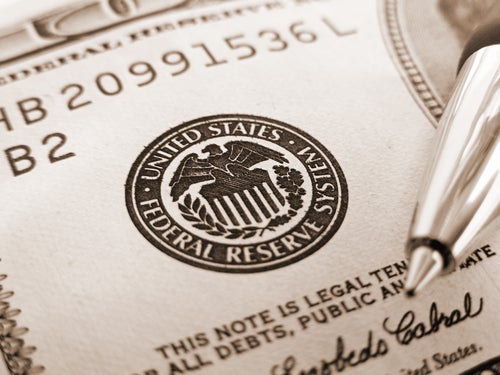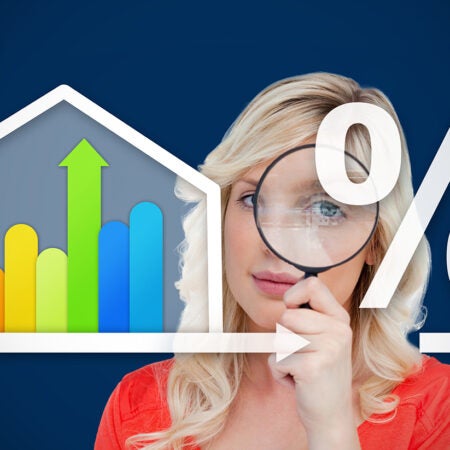
In December 2015 the Federal Reserve raised its key interest rate (what banks charge each other for overnight lending) ever so slightly. The range moved up from 0% – 0.25% to 0.25% – 0.5%. The Fed doesn’t control interest rates on consumer financial products like mortgages and personal loans, but as the cost fluctuates, banking institutions adjust their own rates accordingly (both the rates they charge for loans as well as the rates they pay for savings).
Rising interest rates are never good for borrowers. Any time the Fed bumps the cost of money upward, consumers should be alert for the cost of lending to go up, also.
Savers, on the other hand, can benefit from a hike. After the Fed raises rates, consumers with money in the bank should eventually see a little bit more interest earnings on their savings. Don’t hold your breath for that to happen, though. Even while some banks upped interest rates on the money they lend, they haven’t yet begun to pay any more for the privilege of holding your cash. Most savings accounts earn a fraction of a percent, with some standout banks offering just over one percent. Larger balances earn more, but not significantly more.
How the Fed affects mortgages in 2016
In theory, a Fed rate hike should cause mortgage rates to rise. When banks pay more for the money they use, they charge customers more for loans. In reality, the recent increase was so small, banks haven’t reacted strongly. Today (February, 2016), mortgages cost about the same as they did in October, 2015. For a 30-year, fixed rate loan for borrowers with excellent credit pay between 3.5% and 3.9%.
Mortgage costs are likely to go up a half percent or so later this year, because the Federal Reserve has indicated that it plans to continue to gradually raise rates. The more you borrow, the more you’ll notice the difference. On $100,000, an extra quarter percent costs about $11 extra per month. On $400,000, the difference is over $43. Once we see rates go a full percentage point higher, the additional cost on that larger amount quadruples to $172 per month. On the bright side, when mortgage rates go up, home prices often respond by coming down.
Recommendation
Homebuyers: Don’t immediately rush into a mortgage in anticipation of rising rates. Interest changes in 2016 will be small and measured. Focus first on getting your credit into good enough shape to qualify for the best rates, and save the biggest down payment you possibly can.
Homeowners: If you have an adjustable-rate mortgage, expect the rate to go up. Refinancing this year at a fixed rate may be in your best interests. If you need to borrow against the equity in your home, take a fixed-rate loan instead of a variable-rate line of credit.
How the Fed rate will affect student loans
Federal student loan rates are set by Congress, and as of 2013 the rates on most federal student loans are pegged to the yield on the 10-year Treasury note, plus 2.05% (for graduate student loans, the add-on is 3.6%; for PLUS loans it’s 4.6%). For the 2015-2016 school year the direct subsidized and unsubsidized loan rate for undergraduates is 4.29%; it is capped at 8.25%. The rates and caps are a bit higher for graduate and PLUS loans.
About 93% of student debt is in the form of federal loans, and most of those loans have a fixed interest rate. No matter what happens to marketplace interest rates, existing student loans will not be affected by a rate change.
Borrowers who have older, variable-rate federal loans or variable-rate private student loans will probably see their rates rise. Private loan borrowers should pay special attention; those lenders are not subject to the rate cap mentioned above.
Recommendation
If you have old federal loans at a higher or variable rate, consolidate them to the low fixed rate this year.
If you have variable rate private loans, refinance them into a fixed-rate loan. Avoid taking new private student loans unless you have a very short plan for payoff. Private loans don’t come with the many benefits of federal loans, including flexible repayment options.
Never borrow more than you need.
How the Fed rate hike affects other personal loans
Like mortgages, rates on other loans, such as personal loans, auto loans and business loans, will rise in response to the Fed’s increases this year (some immediately, some eventually).
Interest rates on most credit cards and home equity lines of credit are variable. Expect them to rise within one to three months after a Fed rate increase. Watch for the first increases to come in March, if they haven’t already. Also, zero percent introductory offers might start to dry up as rates rise.
Auto loans follow the prime rate, which is not the same as the Fed rate, but is influenced by it. Higher rates might motivate some consumers to buy a less expensive car. That said, the current quarter-point increase has very little impact on out-of-pocket cost and is unlikely to noticeably affect car shopping budgets. Also, as rates go higher, auto-makers may try to hold onto sales momentum by subsidizing the cost of borrowing or offering other financial incentives.
Recommendation
If you have variable rate debt, take stock of it and make a payoff plan. The Federal Reserve has indicated clearly that it expects to continue to make small increases in its rate. The quarter-point increase in December might not make much of a difference in your wallet today, but the succession of planned small increases will add up to higher costs by next year when you’ll have to pay more each month if you want to pay the debt off on schedule.
If you have a need for financing soon, get your credit in shape so that you can apply in 2016, since rates are likely to be higher next year.
Related Articles:
Here’s How You Can Lower Your Interest Rates for Everything
American Currency Through History
Owe Taxes to the Federal Government? How to Preserve your Finances and Credit Score
Questions about credit repair?
Chat with an expert: 1-800-255-0263






